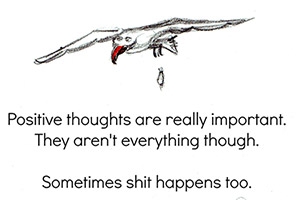How Environmental Triggers Age You, Make You Dumber and Change How You See Other People
You know you're affected by what's around you, but did you realize how much?
 The brain is continually responding to all sorts of stimuli you're not consciously aware of.
The brain is continually responding to all sorts of stimuli you're not consciously aware of.I found myself feeling down. It wasn't like me.
I was presenting a three-day workshop in Northern Ireland and staying in a large hotel. I felt sad in the elevator, sad in the dining room, just sad. It took me a while to notice something that I guess should have been obvious.
Everywhere you went in the place you could hear the most depressing music. It was Karen Carpenter at her most maudlin, The Smiths at their gloomiest, and the most mournful country and western music I'd ever heard. It was relentless and constant.
The point is I hadn't consciously noticed at first, but I had been affected. And I wasn't alone: everyone around me seemed to have the ghostly appearance of having lost any vestige of enjoyment or energy.
Environment matters. And I want to show you just how much.
Hypnotic suggestibility happens all the time
That's the key idea here. And it is often the case that the source of a 'suggestion' is actually not a hypnotist as such, but the environment itself. This may work for us or against us. Sometimes, too, it may have little impact at all. But some environmental influences are much more subtle than my example of wall-to-wall melancholic melodies.
For example, research (Holland, Hendriks, & Aarts, 2005) has shown that a subtle background aroma of cleaning liquid in the air influences people to be perceptibly cleaner and tidier than they would otherwise be. So if you want people to be clean in your house that may be something to think about. But this business of environmental influence gets stranger.
Warm drinks make you friendlier
Another fascinating piece of research reported in the journal Science in October 2008 involved hot and cold cups of coffee (Williams & Bargh, 2008). Students were asked to hold a cup of coffee in their hands for a few seconds before reading an information pack about a hypothetical person and then assessing this person's 'character'.
The students who had etheld a hot cup of coffee were significantly more likely to describe the hypothetical individual as 'warm and friendly' than the students who had held an iced coffee.
Just the immediate environment of their hands had seeded their unconscious minds, and, although they all read the very same information about the imaginary individual, their responses were largely in accord with the environmental 'suggestion'.
Want to feel young? Your environment plays a role there too.
Triggers that age you
I've often suspected that being surrounded by sick people in hospital, or by old and frail people in aged care, while perhaps unavoidable sometimes, may have unconscious insidious effects on the way we become.
In other research (Bargh, Chen, & Burrows, 1996), students who were exposed to environmental triggers that seeded the pattern for 'old' and 'frail', such as sitting in a professor's office surrounded by pictures of very old people and with words like gray, infirm, weak, old, slow, tired being both used by the professor and subliminally scattered on posters and leaflets, tended to walk out of the office much more slowly than they'd walked in.
In contrast, students unconsciously exposed to patterns of youth, vitality, energy and strength walked out of the office more quickly than they'd walked in.
Think for a moment about the 'messages' or 'suggestions' in your environment. Could you consciously seek to enhance what is around you?
I was at a train station the other day. Every public information poster seemed to suggest fear and suspicion.
- If you see something suspicious report it!
- Any unattended items may be destroyed!
- Danger of death if you fall onto the tracks!
Again, some of this may be necessary - but what is its cumulative effect on the human psyche?
Even a single item in our field of view can be enough to affect us.
What your phone is doing to your intelligence
You may have seen the research that demonstrated that having a phone in sight, even if it's switched off, can make us dumber (Ward et al., 2017). Presumably this is because we associate it with flitting and lack of sustained focus. But single-item environmental influences extend well beyond technology.
People will behave more competitively if there's a briefcase in sight - or even if there is a picture of a briefcase on the wall (Kay et al., 2004; Rigoglioso, 2004)! What's more, this happens even to people who later report having no conscious memory of having seen the briefcase.
In the same vein, people are more cooperative when they glimpse words like dependable and support - all without even being aware of the change, let alone what prompted it (Kay et al., 2004;).
So the environment we find ourselves in has a highly hypnotic effect on us. Years ago I used to see many of my hypnotherapy clients at my home. I was struck by how many of my clients reported they always felt like smiling upon leaving a session.
Only after some months did I notice that my little son had stuck a tiny smiley sticker on the door to my clinic room. It was visible, but so small that it would have been hardly noticeable to people leaving the room.
We pay taller men higher salaries, men find women dressed in red more attractive, and, in turn, women find a man more attractive if other women are smiling at him. Even in a photo, a man's face tends to be deemed more attractive if it's surrounded by smiling women (Jones et al., 2007).
So what does all this mean for us?
Choose your words carefully
Environmental triggers influence people's behaviours and responses to a much greater extent than we realize. But a vital point to remember here is that words form a very important part of our environment.
Think how you'd feel if you went out for the evening with someone who peppered their conversation with words like down, depressed, pointless, hurt, painful, despair, stupid, bad, tired, fed up, sad, nauseous, sick, ill, disappointed, and so forth. This person would have effectively built up an 'environment of words' around you, to which you might begin to respond just as surely as you might to the smell of disinfectant or relaxing background music.
Surgeons who use words like pain, hurt, wound, agony, blood, uncontrolled, and so on are unwittingly building a negative environment for their unfortunate patient to inhabit, and seeding ideas and responses.
I'm sure the majority of terrified flyers are completely unaware, on a conscious level, of all the frightening words and language styles that surround them at the airport. As soon as you arrive, you are looking for the word 'Terminal' - a word that regularly triggers associations of death. Next, you wait in the 'final departure' lounge for your 'final call'. No wonder some flying phobics have a sense of foreboding at airports!
Ideas, concepts, and words form an important part of our environments.
But we don't need to be victimized by them. On the contrary, we can use them to our advantage.
How to shape the world of those around you
When you use language, think of yourself as literally building an environment for someone else to inhabit and respond to.
This is not to say that we should always avoid unpleasant words, but it's important to be aware of how we construct what we might call 'linguistic environments' - and therefore expectations - with the words that we use.
For example, I prefer to use the word 'healing' when talking about the response of the body and mind when someone stops smoking, rather than the word 'withdrawal', which seeds quite another expectation.
So why does the mind respond to its environment in this hypersensitive way?
The knee-jerk responses of the unconscious mind
Keeping us safe is a major part of the role of the unconscious mind. It needs to be able to do this very speedily in case we need to make quick decisions. So it does something called 'thin slicing'. This means it takes one small element of reality and generalizes it, then uses that generalization to determine what behaviour to adopt. Appearances may be deceptive, of course, so developing the ability not to do this on occasion gives us the power to move beyond the limitations of this mechanism.
So it's true to say we respond much more powerfully to our environment than we realize. The very words you yourself use, along with other aspects of your communication, help to create an environment for others. This is why seeding, or priming as it's sometimes called, is so powerful.
How can this knowledge help you convince or influence others - other than by scenting the air with cleaning fluid, sticking up smiley faces or handing someone a warm cup of coffee when you want a 'warm' response?
Bypassing automatic resistance
A skilled hypnotic communicator knows how to deliver suggestions indirectly. Why?
Well, imagine you have a rebellious teenage son or daughter. You beg, demand, or threaten them to clean their room, to keep the place clean and tidy, but the more directly you appeal to them, the higher their hackles rise. This is sometimes known as the 'rubber band effect'. The more you pull one way, the more resistance you create, and the more the 'rubber band' wants to go back the other way.
The direct approach often just doesn't work. That faint whiff of cleaning fluid is more likely to make your teenager start being cleaner because the seed is unconscious - and therefore the environmental suggestion, as it were, meets no automatic conscious resistance.
So how can we seed positive ideas indirectly and therefore bypass automatic resistance in someone?
First set the scene
There are many ways to subtly and indirectly seed suggestions in ways that appeal to the unconscious part of the brain - which is, after all, the part that actually gets us feeling better or motivates us to behave more constructively.
You can use hypnotic presuppositions to subtly imply a certain outcome without demanding it, for instance, or tell metaphorical stories that have words and patterns within them to help effectively seed ideas.
For example, when I want someone to switch off physical pain, I first seed the general pattern of people experiencing comfort or even numbness or anaesthesia. I might talk about the idea of playing in the snow without gloves and build up a feeling of how after a while the freezing-cold hands can almost feel like they are not part of you. Tying shoelaces becomes harder, and using a key in a lock might feel strange.
I don't directly suggest they, the client, experience this - but I've evoked the pattern. I might talk about what it feels like to wake up after having been asleep on an arm, or sitting for so long a leg has gone numb. It's amazing how you can evoke profound hypnotic experience simply by communicating these universal examples and therefore create a pattern of environment to which your client can respond.
Remember, people are much more likely to respond to a suggestion you are seeding if it fits a general pattern that they can already relate to. The whiff of cleaning agent sets a general pattern of cleanliness - which can then be extrapolated by the unconscious mind to motivate cleaner behaviour for that individual.
So what else can you do?
Change the outside to change your inside
So, it's clear that our environment has a profound impact on our psychology, even to the extent that it can influence how quickly we heal (Ulrich, 2000). I always recommend that someone grieving the loss of a relationship, perhaps after a divorce, change things in their environment.
One woman told me that she only started feeling better again when she finally changed the colour of the walls and made other decorative changes after her husband had left her.
Or, more generally, it can be useful to fill your environment with things that make you feel good: photos that evoke great times, wonderful places you've been to, or people that inspire you. If you like nature but don't live near it, then put up pictures of natural scenes. Use scents that make you feel invigorated, or relaxed.
One of the quickest ways to lift insomnia, for some people, is to move the bed to a different place and rearrange other parts of the bedroom so that it feels different for the person. The old automatic environmental associations of stress about not sleeping are disrupted.
If someone has spent a hundred anxious and sleepless nights in a room, then the room itself can act as a massive trigger not to sleep. Change the trigger, and you might just change the response.
So think about updating your environment, sometimes putting new things into it and perhaps removing some things that may have been acting as subliminal negative triggers. And be aware of the patterns of words people in your life use.
Back in that hotel in Northern Ireland I eventually realized that all the soul-crushing music, with no shades of light, was creating an unremitting pattern of bleakness. I suggested to the hotel staff they mix in some slightly less dispiriting tracks. And they actually took my advice. Result? The mood of the whole place seemed to lift.
Of course, it's not just music, or words, or other subtle aspects of your environment that influence you. But make no mistake, your environment will influence you to some, even to a great, extent.
In summary:
- We are all highly susceptible to environmental triggers and these triggers can powerfully seed responses in us.
- Language is as much a part of our environment as what we smell, taste, touch, and see.
- Suggestions can become much more powerful if seeded with universal patterns that people can relate to easily (as in the example of talking about a leg 'going to sleep' to seed hypnotic anaesthesia).
- It's very important to be aware of the triggers in your own environment and, as far as possible, ensure that you surround yourself with items that produce positive associations within you.
For more on how to use language to influence, see our free online self hypnosis course.
References
- Bargh, J. A., Chen, M., & Burrows, L. (1996). Automaticity of social behavior: Direct effects of trait construct and stereotype-activation on action. Journal of Personal and Social Psychology, 71(2), 230-244.
- Holland, R. W., Hendriks, M., & Aarts, H. (2005). Smells like clean spirit: Nonconscious effects of scent on cognition and behavior. Psychological Science, 16(9), 689-693.
- Jones, B. C., DeBruine, L. M., Little, A. C., Burriss, R. P., & Feinberg, D. R. (2007, March 22). Social transmission of face preferences among humans. Proceedings oif the Royal Society: Biological Sciences, 274, 899-903
- Kay, A. C., Wheeler, S. C., Bargh, J. A., & Ross, L. (2004). Material priming: The influence of mundane physical objects on situational construal and competitive behavioral choice. Organizational Behavior and Human Decision Processes, 95(1), 83-96.
- Rigoglioso, M. (2004, October 1). Even the furniture can affect business attitudes. Stanford Graduate School of Business.
- Ulrich, R. S. (2000). Effects of healthcare environmental design on medical outcomes. Design & Health World Congress & Exhibition (WCDH 2000, Stockholm)
- Ward, A. F., Duke, K., Gneezy, A., & Bos, M. W. (2017). Brain drain: The mere presence of one's own smartphone reduces available cognitive capacity. Journal of the Association for Consumer Research, 2(2), 140-154.
- Williams, L. E., & Bargh, J. A. (2008). Experiencing physical warmth promotes interpersonal warmth. Science, 322(5901): 606-607.






